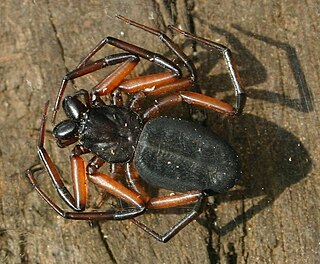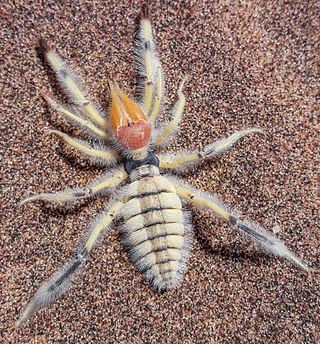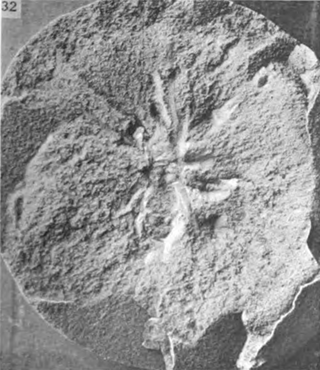
The subphylum Chelicerata constitutes one of the major subdivisions of the phylum Arthropoda. It contains the sea spiders, horseshoe crabs, and arachnids, as well as a number of extinct lineages, such as the eurypterids and chasmataspidids.

Arachnida is a class of joint-legged invertebrate animals (arthropods), in the subphylum Chelicerata. Arachnida includes, among others, spiders, scorpions, ticks, mites, pseudoscorpions, harvestmen, camel spiders, whip spiders and vinegaroons.

The Opiliones are an order of arachnids colloquially known as harvestmen, harvesters, harvest spiders, or daddy longlegs. As of April 2017, over 6,650 species of harvestmen have been discovered worldwide, although the total number of extant species may exceed 10,000. The order Opiliones includes five suborders: Cyphophthalmi, Eupnoi, Dyspnoi, Laniatores, and Tetrophthalmi, which were named in 2014.

The chelicerae are the mouthparts of the subphylum Chelicerata, an arthropod group that includes arachnids, horseshoe crabs, and sea spiders. Commonly referred to as "jaws", chelicerae may be shaped as either articulated fangs, or similarly to pincers. Some chelicerae, such as those found on nearly all spiders, are hollow and contain venom glands, and are used to inject venom into prey or a perceived threat. In Pisaurina mira, also known as the nursery web spider, the chelicerae are utilized to snatch the prey once it becomes within reach, facilitating the "sit-and-wait ambush predator" behavior. Both pseudoscorpions and harvestmen have structures on their chelicerae that are used for grooming.

Solifugae is an order of animals in the class Arachnida known variously as camel spiders, wind scorpions, sun spiders, or solifuges. The order includes more than 1,000 described species in about 147 genera. Despite the common names, they are neither true scorpions, nor true spiders. Most species of Solifugae live in dry climates and feed opportunistically on ground-dwelling arthropods and other small animals. The largest species grow to a length of 12–15 cm (5–6 in), including legs. A number of urban legends exaggerate the size and speed of the Solifugae, and their potential danger to humans, which is negligible.

Ammotrechidae is a family of solifuges distributed in the Americas and the Caribbean Islands. It includes 26 described genera and 95 species. Members of this family can be distinguished from members of other families by the absence of claws on tarsi of leg I, tarsal segmentation 1-2-2-(2-4), pedipalps with pairs of lateroventral spines, and by males having an immovable flagellum on the mesal face of each chelicerum. The propeltidium of the Ammotrechidae is recurved.

The Angolan slender mongoose is a mongoose native to southwestern Africa, specifically southwestern Angola and northwestern Namibia. It has been listed as "Least Concern" on the IUCN Red List, as it is not threatened and thought to be common. It has a long, slim body and there are different colour forms, a black or dark brown form in the southern part of its range, and a yellowish- or reddish-brown form in the north. This mongoose inhabits dry, rocky habitats and feeds on insects, scorpions and small vertebrates.

Platyoides is a genus of spiders belonging to the family Trochanteriidae. Its members are known as scorpion spiders and are found in sub-Saharan Africa and its islands, Madagascar, Réunion, Aldabra and the Canary Islands.

Galeodes is a genus of solifuges or sun spiders. The nearly 200 species in this genus are found in northern Africa, southeastern Europe and Asia. Like other solifuges, they are mainly nocturnal and found in arid habitats. They often have long hairy appendages and are not as stout bodied or dark and contrastingly coloured as some other solifuges. Some Galeodes species are able to produce sounds by stridulation. These are usually raspy or hiss-like and may be imitations of the sounds of vipers, to serve a defensive function. As in other solifuges, mating involves the male depositing a spermatogonia that is manipulated into the female genital opening using their chelicera. The male strokes the female using the palps allowing her to be approached. Females will often feed on males before or after mating. The female then deposits the eggs in a burrow in soil and in some species guards them.

Spiders are air-breathing arthropods that have eight legs, chelicerae with fangs generally able to inject venom, and spinnerets that extrude silk. They are the largest order of arachnids and rank seventh in total species diversity among all orders of organisms. Spiders are found worldwide on every continent except for Antarctica, and have become established in nearly every land habitat. As of August 2022, 50,356 spider species in 132 families have been recorded by taxonomists. However, there has been debate among scientists about how families should be classified, with over 20 different classifications proposed since 1900.

Galeodes arabs, common name Egyptian giant solpugid or camel spider, is a species of solifuges native to North Africa and Western Asia.

Zeria is a genus of solifuges or sun spiders. The species of this genus are found in sub-Saharan Africa.

Solpugidae is a family of solifuges or sun spiders. Solpugidae have groups of papillae on their pedipalps or sensory organs. The papillae come out of sockets that are characterized with the function of mechanoreceptor, and contact chemoreceptors, which allows them to respond to stimuli such as touch and sound.

Zeria loveridgei is a species of solifuges or sun spiders. This species can be found in Somalia and Kenya.

Metasolpuga is a genus of solifuge or sun spider. The monotypic genus contains the species Metasolpuga pictaKraepelin 1899 which is native to Namibia. It is one of several large, diurnal solifuge species that occur in the arid regions of southern Africa.

Protosolpuga carbonaria is an extinct species of solifuges, the only one of the genus Protosolpuga and the family Protosolpugidae. This Carboniferous camel spider was discovered in the Mazon Creek Formation in Illinois.
Cratosolpuga is an extinct genus of solifuge from the Early Cretaceous Araripe Basin of Brazil. It contains the single species Cratosolpuga wunderlichi. The genus is known from and named after the Crato Formation.
Namibesia is a monotypic genus of daesiid camel spiders, first described by Reginald Frederick Lawrence in 1962. Its single species, Namibesiapallida is distributed in Namibia.
Daesiella is a monotypic genus of melanoblossiid camel spiders, first described by John Hewitt in 1934. Its single species, Daesiellapluridens is distributed in Namibia.
Vempironiella is a monotypic genus of mummuciid camel spiders, first described by Ricardo Botero-Trujillo in 2016. Its single species, Vempironiellaaguilari is distributed in Peru.














